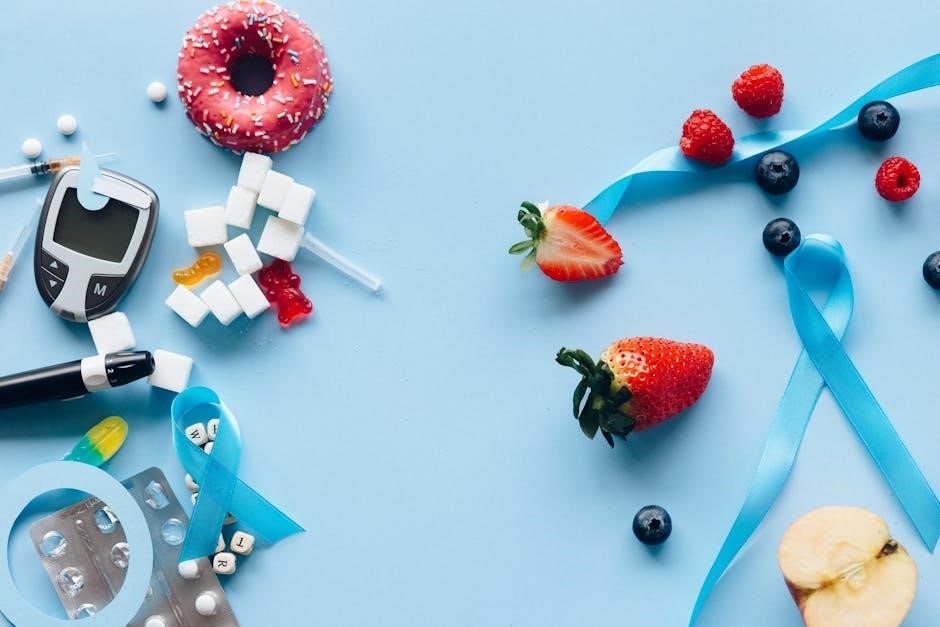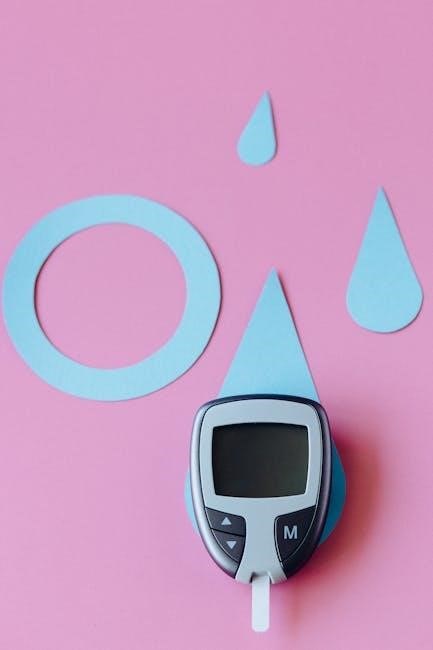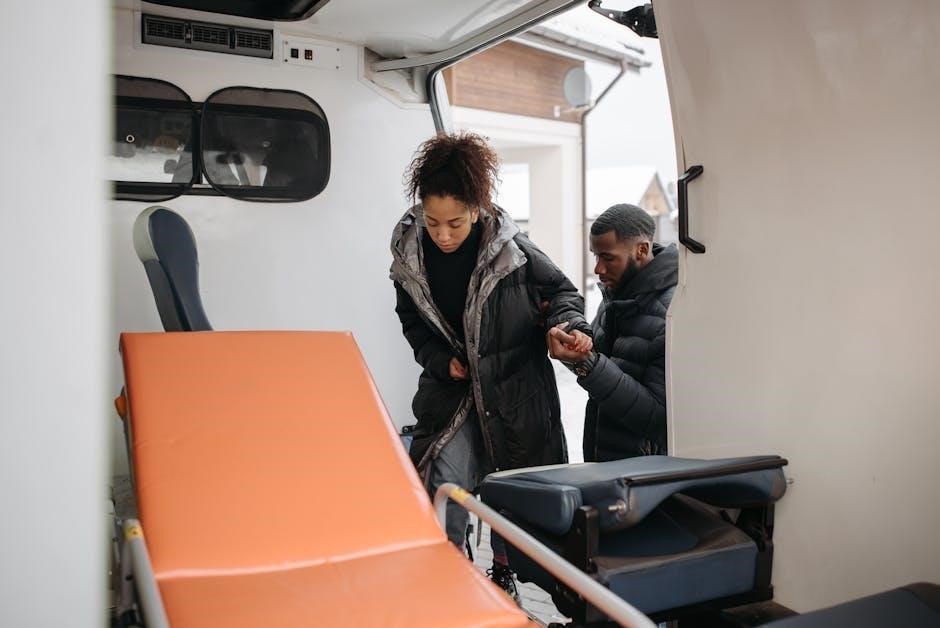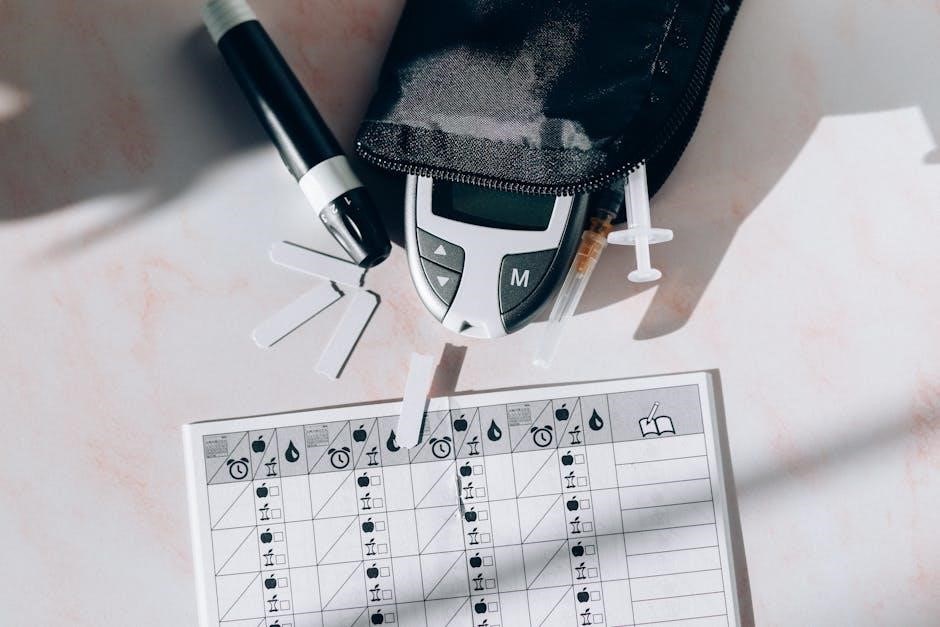Diabetes sick day guidelines provide essential strategies to manage blood glucose during illnesses, preventing complications like hyperglycemia and diabetic ketoacidosis. These plans help maintain control and avoid hospitalization.

Understanding the Importance of Sick Day Management
Effective sick day management is critical for individuals with diabetes to prevent complications like hyperglycemia and diabetic ketoacidosis (DKA). When ill, the body produces stress hormones that raise blood glucose levels, making it harder to control diabetes. Without proper management, high blood sugar can lead to severe health issues. A well-structured sick day plan helps maintain blood glucose balance, ensuring medications like insulin and oral diabetes drugs are adjusted appropriately. It also emphasizes the importance of hydration and nutrition to avoid dehydration and electrolyte imbalances. Monitoring blood glucose and ketone levels regularly is key to early detection of potential problems. By following sick day guidelines, individuals can reduce the risk of hospitalization and manage their condition effectively, even when feeling unwell. This proactive approach ensures better health outcomes and minimizes the impact of illness on diabetes control.
Key Components of a Sick Day Plan
A comprehensive sick day plan includes several essential components to help manage diabetes effectively during illness. First, it involves regular blood glucose monitoring, with frequency increasing during sickness, such as every 2-4 hours. Second, ketone testing is crucial for individuals with type 1 diabetes to detect early signs of diabetic ketoacidosis (DKA). Third, the plan should outline insulin and medication adjustments, ensuring doses are tailored to the individual’s condition and blood sugar levels. Fourth, hydration and nutrition strategies are vital, such as drinking plenty of fluids and consuming small, frequent meals or snacks. Lastly, the plan should include emergency contact information and guidelines for when to seek immediate medical help. Having these components in place ensures better control of diabetes during illness and reduces the risk of complications.

Preparing for Sick Days
Creating a sick day emergency kit with insulin, diabetes medications, and easy-to-make foods ensures readiness. Plan ahead to avoid complications and stay in control during illness.
Why a Sick Day Plan is Essential
A sick day plan is crucial for managing diabetes during illnesses, as it helps prevent blood glucose fluctuations and reduces the risk of complications like diabetic ketoacidosis (DKA). Illnesses often cause blood sugar levels to rise due to increased stress hormones, making it harder to control glucose. Without a plan, hyperglycemia and dehydration can escalate quickly, leading to emergency situations. A well-prepared plan ensures continuous medication use, proper hydration, and frequent blood glucose monitoring, even when eating is challenging. It also provides clear guidelines for adjusting insulin doses and recognizing emergency signs, such as high ketone levels or severe symptoms. By having a structured approach, individuals with diabetes can maintain better control, avoid hospitalization, and recover more effectively. A sick day plan acts as a safety net, offering peace of mind and practical steps to navigate health challenges confidently.

Stocking a Sick Day Emergency Kit
A well-stocked sick day emergency kit is vital for managing diabetes during illnesses. It should include essential supplies like extra insulin, diabetes medications, blood glucose test strips, and ketone test strips. Additionally, fast-acting carbohydrates (e.g., glucose tablets or juice) and snacks (e.g., crackers or granola bars) are crucial for quick blood sugar corrections. Include a list of emergency contact numbers, such as your healthcare provider and local diabetes team. Don’t forget a thermometer, hydration fluids (e.g., water or sugar-free drinks), and electrolyte-rich beverages to prevent dehydration. Store all items in an easily accessible location, ensuring they are within expiration dates. Having a prepared kit reduces stress and ensures you can manage your diabetes effectively during sickness. Regularly update the kit to maintain supplies and stay ready for unexpected illnesses.

Monitoring Blood Glucose and Ketones
Regular blood glucose checks are crucial during illness. Test every 2-4 hours when unwell. Check ketones if blood sugar exceeds 250 mg/dL to prevent diabetic ketoacidosis.
Frequency of Blood Glucose Checks
During illness, blood glucose levels can fluctuate rapidly, making frequent monitoring crucial. For mild illnesses, check blood glucose every 4-6 hours. For severe illnesses, such as the flu, check every 2-4 hours. If blood sugar levels remain elevated or symptoms persist, increase monitoring frequency. Always follow your sick day action plan. Testing more often helps identify changes early and prevents complications like diabetic ketoacidosis. If you have type 1 diabetes, check ketones when blood glucose exceeds 250 mg/dL. For type 2 diabetes, consult your healthcare provider about ketone testing. Keep a log of results to share with your diabetes team. Adjust your plan based on their advice. Consistent monitoring ensures better control and reduces the risk of serious health issues. Stay vigilant and prioritize regular checks to manage your diabetes effectively during sickness.
When and How to Test for Ketones
Ketone testing is crucial for preventing diabetic ketoacidosis (DKA), especially for individuals with type 1 diabetes. Test for ketones if blood glucose exceeds 250 mg/dL, or if symptoms like nausea, vomiting, or fatigue occur. Use a ketone test strip or a blood ketone meter for accurate results. Urine ketone tests are less precise but can provide a general idea. Test in the morning upon waking and whenever symptoms worsen. If ketones are moderate or high, contact your healthcare provider immediately. Do not skip insulin doses, as this can worsen ketone buildup. Follow your sick day plan for adjusting insulin and fluids. Testing ketones helps identify potential complications early, ensuring timely intervention and preventing serious health risks. Regular monitoring is key to maintaining safety and managing diabetes effectively during illness.
Interpreting Blood Glucose Levels During Illness
Blood glucose levels often rise during illness due to stress hormones and reduced insulin sensitivity. High levels can indicate dehydration or infection. If blood glucose exceeds 250 mg/dL, test for ketones to avoid diabetic ketoacidosis (DKA). Low levels may occur if medication isn’t adjusted or if eating is restricted. Monitor blood glucose every 2-4 hours during illness. Elevated levels require increased fluid intake and possible insulin adjustments. If levels remain high or you experience symptoms like nausea or vomiting, contact your healthcare provider. Proper interpretation ensures timely interventions, preventing complications. Always follow your sick day plan and consult your diabetes team for guidance. Accurate interpretation of blood glucose levels is vital for maintaining health and avoiding severe complications during illness.

Insulin and Medication Management
Adjusting insulin doses during illness is crucial to manage high blood glucose levels. Continue taking diabetes medications as prescribed, even if eating is challenging. Never stop insulin abruptly without consulting your healthcare provider, as this can lead to serious complications like diabetic ketoacidosis (DKA). Monitor blood glucose levels frequently and test for ketones if levels exceed 250 mg/dL. Your healthcare team can guide insulin adjustments based on your sick day plan and current condition. Proper medication management ensures stable blood glucose levels and prevents severe health risks during illness.
Adjusting Insulin Doses During Illness
When ill, blood glucose levels often rise due to stress and inflammation. People with diabetes, especially those with type 1, may need to increase insulin doses temporarily. Always consult your healthcare provider before making adjustments. If blood glucose levels exceed 250 mg/dL, check for ketones, as this may indicate the need for additional insulin; For type 2 diabetes, medication adjustments should also be guided by your healthcare team. Never skip insulin doses, even if you’re unable to eat, as this can lead to diabetic ketoacidosis (DKA). Instead, follow your sick day plan, which may include taking smaller, more frequent doses or adjusting basal rates. Monitor blood glucose every 2-4 hours and keep track of results to guide adjustments. Proper insulin management during illness helps prevent complications and maintains glucose control.
Continuing Diabetes Medications When Sick
It is crucial to continue taking diabetes medications as prescribed, even when sick, unless advised otherwise by your healthcare provider. For those on insulin, doses should not be skipped, as this can lead to high blood sugar and potential complications like diabetic ketoacidosis (DKA). If you are unable to eat, consult your healthcare team about-adjusting your insulin doses, but do not stop taking it altogether. For oral medications, continue your usual regimen unless your provider recommends stopping temporarily due to illness-related concerns, such as low blood sugar or dehydration. Always monitor your blood sugar levels closely and stay hydrated by drinking plenty of fluids. Having a sufficient supply of medications at home is essential to avoid interruptions in treatment. If unsure about medication adjustments, contact your healthcare provider for guidance to ensure safe management of your diabetes during illness.
Special Considerations for Type 1 and Type 2 Diabetes

Management strategies for sick days differ slightly between Type 1 and Type 2 diabetes. For Type 1 diabetes, it is critical to continue insulin therapy, as the body cannot produce insulin on its own. Adjustments to insulin doses may be necessary based on blood glucose levels and ketone testing. For Type 2 diabetes, medications should generally be continued unless directed otherwise by a healthcare provider. However, certain medications may need to be paused temporarily if blood glucose levels drop too low or if dehydration occurs. Both types require frequent blood glucose monitoring and hydration. Type 1 diabetes patients should test for ketones when blood glucose exceeds 250 mg/dL to prevent diabetic ketoacidosis (DKA). Type 2 patients should focus on maintaining carbohydrate intake and avoiding fasting; Consulting a healthcare provider for personalized advice is essential for both types to ensure safe and effective management during illness.

Nutrition and Hydration
Stay hydrated with water or sugar-free fluids, and eat small, frequent meals rich in carbohydrates if possible. If nausea occurs, opt for bland foods or electrolyte-rich drinks to maintain balance.
Staying Hydrated When Sick
Staying hydrated is crucial when managing diabetes during illness. Drink plenty of fluids, such as water, clear broths, or sugar-free beverages, to prevent dehydration and help regulate blood glucose levels. Aim for 6-8 ounces of liquid every hour while awake, even if you’re not eating. If vomiting occurs, try small sips of fluids to avoid overwhelming your stomach. Opt for electrolyte-rich drinks like Pedialyte or sports drinks to replace lost salts and minerals. Avoid sugary drinks that can spike blood sugar. If you’re unable to eat, consider carbohydrate-containing liquids like juice or glucose gels to maintain energy and hydration. Proper hydration helps prevent ketone buildup and supports overall health during recovery. Consistent fluid intake is key to managing diabetes effectively when sick.

Carbohydrate Intake and Blood Sugar Control
Maintaining proper carbohydrate intake is vital for blood sugar control when sick. Even if you’re not eating solid foods, consume small, frequent portions of carbohydrates to prevent hypoglycemia. Opt for low-fat, easily digestible foods like crackers, toast, or plain rice. If nausea or vomiting makes eating difficult, try carbohydrate-containing liquids such as juice, glucose gels, or sports drinks. These can help stabilize blood glucose levels without overwhelming your stomach. Monitor your blood sugar frequently and adjust your carbohydrate intake based on the results. If you’re unable to eat, consult your diabetes care team for guidance on managing your medication and insulin doses. Proper carbohydrate intake ensures energy levels are maintained and helps prevent blood sugar fluctuations during illness. Balancing carbs with hydration and medication is essential for effective diabetes management when unwell.
Managing Nausea and Vomiting
Nausea and vomiting can make managing diabetes challenging, as they affect eating and hydration. If you experience these symptoms, prioritize small, frequent sips of fluids like water, clear broth, or electrolyte-rich beverages to stay hydrated. For carbohydrates, opt for easily digestible foods such as crackers, toast, or plain rice. If vomiting persists, consider sugar-free liquids or ice cream to maintain some carbohydrate intake without triggering further nausea. Avoid fatty or heavy foods that may worsen symptoms. If you cannot keep food or liquids down for more than 4 hours, contact your healthcare provider for guidance. Proper management of nausea and vomiting is crucial to prevent blood sugar imbalances and complications like diabetic ketoacidosis (DKA). Always follow your sick day plan and consult your diabetes care team if symptoms persist or worsen.

Recognizing Emergency Situations
Recognizing emergency situations involves identifying severe hyperglycemia, high ketone levels, confusion, rapid breathing, or fruity breath odor, which may signal diabetic ketoacidosis (DKA), requiring immediate medical attention.
Signs of High Blood Sugar and Ketone Buildup
High blood sugar during illness can lead to symptoms like increased thirst, frequent urination, fatigue, and blurred vision. Prolonged hyperglycemia may cause nausea, vomiting, and abdominal pain. Ketone buildup, particularly in Type 1 diabetes, can result in fruity breath odor, rapid breathing, and confusion. If blood glucose exceeds 250 mg/dL, ketone testing is crucial; Elevated ketones indicate potential diabetic ketoacidosis (DKA), a medical emergency requiring immediate attention. Symptoms of DKA include excessive thirst, dry mouth, flushed skin, and loss of consciousness. Monitoring blood glucose and ketones during sickness helps identify these warning signs early. Prompt action, such as adjusting insulin doses or seeking medical help, can prevent severe complications. Recognizing these signs is vital for effective sick day management and maintaining health stability.
When to Contact Your Healthcare Provider
It is crucial to contact your healthcare provider if you experience severe symptoms or if your condition worsens. Seek immediate medical help if your blood glucose levels remain above 250 mg/dL, especially with ketone buildup. Other urgent signs include persistent nausea, vomiting, or inability to eat or drink. If you notice symptoms like confusion, rapid breathing, or fruity breath odor, which may indicate diabetic ketoacidosis (DKA), call your provider right away. Additionally, contact them if you have a fever lasting more than 24 hours or if your blood glucose levels are unstable despite following your sick day plan. Your healthcare provider can offer guidance on adjusting medications or provide emergency care if needed. Early intervention is key to preventing complications and ensuring your safety during illness.
Emergency Care for Diabetic Ketoacidosis (DKA)
Diabetic ketoacidosis (DKA) is a life-threatening emergency requiring immediate medical attention. If you or someone with diabetes experiences symptoms such as severe nausea, vomiting, abdominal pain, rapid breathing, confusion, or fruity-smelling breath, seek emergency care. DKA occurs when the body produces excessive ketones due to insufficient insulin, often triggered by illness, infection, or missed insulin doses. Without prompt treatment, DKA can lead to coma or death. In a hospital setting, treatment involves intravenous fluids to correct dehydration, electrolyte replacement to stabilize heart function, and insulin administration to lower ketone levels. If you suspect DKA, call emergency services or go to the nearest emergency room immediately. Delaying care can worsen the condition, so act quickly to ensure proper treatment and prevent complications.
Effective sick day management is crucial for preventing complications. For more guidance, consult resources from Fraser Health, Joslin Diabetes Center, or UMass Diabetes Center. Plan ahead.
Summarizing Sick Day Management Strategies
Effective sick day management involves monitoring blood glucose frequently, staying hydrated, and adjusting insulin or medication doses as needed. Check for ketones if blood sugar exceeds 250 mg/dl, especially for type 1 diabetes. Maintain carbohydrate intake, even with smaller, more frequent meals, and avoid fasting. Continue taking prescribed diabetes medications unless advised otherwise by your healthcare provider. Seek emergency care if symptoms like severe hyperglycemia, vomiting, or confusion persist. Prepare a sick day kit with essential supplies, including test strips, insulin, and fluids. Communicate with your diabetes care team for personalized adjustments and follow a structured plan to prevent complications like DKA. Regular follow-ups ensure timely interventions, keeping you safe and healthy during illness.
Where to Find More Information and Support
For additional resources on diabetes sick day management, consult reputable organizations like the American Diabetes Association (ADA) or the Joslin Diabetes Center. Their websites offer detailed guides and downloadable PDFs, such as the “Diabetes Sick Day Guidelines” from UMass Diabetes Center of Excellence. Online forums and support groups, like Diabetes.org or Diabetes Support Groups, provide shared experiences and advice. Telehealth services and diabetes education centers also offer personalized guidance. Download apps like MySugr or Diabetes Connect for tracking and management tools. Always consult your healthcare provider for tailored advice. Building a strong support network and staying informed ensures better diabetes care during illness. Visit trusted sources regularly to stay updated on the latest sick day management strategies.
